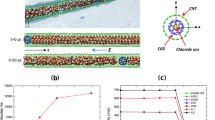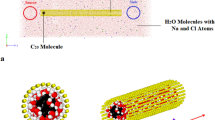Abstract
Nano-pumping of molecules via a carbon nanotube (CNT) can be achieved by mechanical actuation and wave propagation through the tube wall which is generated by two oscillating tips. By using non-equilibrium molecular dynamics (NEMD) simulations, we investigate the effects of tip frequency and amplitude in the pumping of a C20 molecule through (13, 0) CNT in the vacuum environment. The pumping action (C20 ejection) does not succeed in all tip frequencies and amplitudes, and there are optimum points in which successful pumping takes place. In one of these successful pumping conditions (specific tip frequency and amplitude), we have performed NEMD simulations of water and fullerene pumping in an aqueous environment and found that mechanical wave propagation is much weaker in such an environment and the pumping of C20 molecule does not succeed. Our simulations show that mechanical wave velocity along CNT can reach as a high as 5000 m/s. And during the pumping process, the C20 molecule accelerates due to transferring kinetic energy and the velocity remains constant since no external force is applied on C20 molecule.










Similar content being viewed by others
References
D. Qian, G.J. Wagner, W.K. Liu, M.F. Yu, R.S. Ruoff, Mechanics of carbon nanotubes. Appl. Mech. Rev. 55, 495 (2002)
H. Qiu, R. Shen, W. Guo, Vibrating carbon nanotubes as water pumps. Nano Res. 4, 284 (2011)
J.A. Thomas, A.J.H. McGaughey, Reassessing fast water transport through carbon nanotubes. Nano Lett. 8, 2788 (2008)
J. Tao, X. Song, T. Zhao, H. Liu, Confinement effect on water transport in CNT membranes. Chem. Eng. Sci. 192, 1252 (2018)
K. R. Kunduru, M. Nazarkovsky, S. Farah, R. P. Pawar, A. Basu, A. J. Domb, Nanotechnology for water purification: applications of nanotechnology methods in wastewater treatment. Water Purification: 33–74 (2017).
M.F. Hossain, Water, Sustainable Design and Build (Elsevier, New York, 2019), pp. 301–418
A.M. Kheirabadi, A. Moosavi, A.M. Akbarzadeh, Nanofluidic transport inside carbon nanotubes. J. Phys. D Appl. Phys. 47, 065304 (2014)
J.A. Thomas, A.J.H. McGaughey, Density, distribution, and orientation of water molecules inside and outside carbon nanotubes. J. Chem. Phys. 128, 084715 (2008)
M. Chen, J. Zang, D. Xiao, C. Zhang, F. Liu, Nanopumping molecules via a carbon nanotube. Nano Res. 2, 938 (2009)
R. Rajegowda, S.P. Sathian, Analyzing thermophoretic transport of water for designing nanoscale-pumps. Phys. Chem. Chem. Phys. 20, 30321 (2018)
V. Vijayaraghavan, C.H. Wong, Torsional characteristics of single walled carbon nanotube with water interactions by using molecular dynamics simulation. Nano-Micro Lett. 6, 268 (2014)
Z. Insepov, R.J. Miller, Activation of nanoflows for fuel cells. J. Nanotechnol. Eng. Med. 3, 025201 (2012)
B.H. Chen, C. Kung, I. Chu, Mechanisms of hydrogen transport in flexible-wall narrow carbon nanotubes. J. Nanomater. 7, 1 (2015)
P. Král, D. Tománek, Laser-driven atomic pump. Phys. Rev. Lett. 82, 5373 (1999)
H.J. Hwang, K.R. Byun, J.W. Kang, Carbon nanotubes as nanopipette: modelling and simulations. Physica E 23, 208 (2004)
D. Schebarchov, S.C. Hendy, Capillary absorption of metal nanodroplets by single-wall carbon nanotubes. Nano Lett. 8, 2253 (2008)
P. Sahu, A.S. Deb, S.K. Ali, K.T. Shenoy, S. Mohan, Tailoring of carbon nanotubes for the adsorption of heavy metal ions: molecular dynamics and experimental investigations. Mol. Syst. Des. Eng. 3, 917 (2018)
J.K. Holt, Fast mass transport through Sub-2-nanometer carbon nanotubes. Science 312, 1034 (2006)
L. Zhang, B. Zhao, C. Jiang, J. Yang, G. Zheng, Preparation and transport performances of high-density, aligned carbon nanotube membranes. Nanoscale Res. Lett. 10, 266 (2015)
B. Lee, Y. Baek, M. Lee, D.H. Jeong, H.H. Lee, J. Yoon, Y.H. Kim, A carbon nanotube wall membrane for water treatment. Nat. Commun. 14, 7109 (2015)
T. Altalhi, M. Ginic-Markovic, N. Han, S. Clarke, D. Losic, Synthesis of carbon nanotube (CNT) composite membranes. Membranes 1, 37 (2010)
S.K. Kushwaha, S. Ghoshal, A.K. Rai, S. Singh, Carbon nanotubes as a novel drug delivery system for anticancer therapy: a review. Braz. J. Pharm. Sci. 49, 629 (2013)
P.M. Costa, M. Bourgognon, J.T. Wang, K.T. Al-Jamal, Functionalized carbon nanotubes: from intracellular uptake and cell-related toxicity to systemic brain delivery. J. Control. Release 241, 200 (2016)
V. Rastogi, P. Yadav, S.S. Bhattacharya, A.K. Mishra, N. Verma, A. Verma, J.K. Pandit, Carbon nanotubes: an emerging drug carrier for targeting cancer cells. J. Drug Deliv. 2014, 1 (2014)
W. Zhang, Z. Zhang, Y. Zhang, The application of carbon nanotubes in target drug delivery systems for cancer therapies. Nanoscale Res. Lett. 6, 555 (2011)
A.C. Tripathi, S.A. Saraf, S.K. Saraf, Carbon nanotropes: a contemporary paradigm in drug delivery. Materials 8, 3068 (2015)
S. Senapati, A.K. Mahanta, S. Kumar, P. Maiti, Controlled drug delivery vehicles for cancer treatment and their performance. Signal Trans. Targeted Ther. 3, 7 (2018)
Z. Khatti, S.M. Hashemianzadeh, S.A. Shafiei, A Molecular Study On Drug Delivery System Based On Carbon Nanotube Compared To Silicon Carbide Nanotube For Encapsulation Of Platinum-Based Anticancer Drug. Adv. Pharm. Bull. 8, 163 (2018)
J. Chen, D. Mao, X. Wang, G. Zhou, S. Zeng, L. Chen, C. Dai, S. Feng, Encapsulation and release of drug molecule pregabalin based on ultrashort single-walled carbon nanotubes. J. Phys. Chem. C 123, 9567 (2019)
Y.J. Dappe, Encapsulation of organic molecules in carbon nanotubes: role of the van der Waals interactions. J. Phys. D Appl. Phys. 47, 083001 (2014)
B. Corry, Water and ion transport through functionalised carbon nanotubes: implications for desalination technology. Energy Environ. Sci. 4, 751 (2011)
A. Mejri, D. Vardanega, B. Tangour, T. Gharbi, F. Picaud, Encapsulation into carbon nanotubes and release of anticancer cisplatin drug molecule. J. Phys. Chem. B 119, 604 (2015)
Q. Wang, Wave propagation in carbon nanotubes via nonlocal continuum mechanics. J. Appl. Phys. 98, 124301 (2005)
J.A. Elliott, J.K. Sandler, A.H. Windle, R.J. Young, M.S. Shaffer, Collapse of single-wall carbon nanotubes is diameter dependent. Phys. Rev. Lett. 92, 095501 (2004)
S. K. Deb Nath, S. G. Kim, Study of the Nanomechanics of CNTs under Tension by Molecular Dynamics Simulation Using Different Potentials. ISRN Condensed Matter Physics 2014, 1 (2014).
J.V. Beckers, C.P. Lowe, S.W. De Leeuw, An iterative PPPM method for simulating coulombic systems on distributed memory parallel computers. Mol. Simul. 20, 369 (1998)
S.M. Rassoulinejad-Mousavi, Y. Zhang, Interatomic potentials transferability for molecular simulations: a comparative study for platinum, gold and silver. Sci. Rep. 8, 2424 (2018)
K. Okhotnikov, B. Stevensson, M. Edén, New interatomic potential parameters for molecular dynamics simulations of rare-earth (RE = La, Y, Lu, Sc) aluminosilicate glass structures: exploration of RE3+ field-strength effects. Phys. Chem. Chem. Phys. 15, 15041 (2013)
M. Warrier, P. Pahari, S. Chaturvedi, Interatomic potential parameters for molecular dynamics simulations of RDX using a reactive force field: A validation study. J. Phys Conf. Ser. 377, 012100 (2012)
S. Plimpton, Fast parallel algorithms for short-range molecular dynamics. J. Comput. Phys. 117, 1 (1995)
P. Liu, J.-H. He, Geometric potential: an explanation of nanofiber’s wettability. Therm. Sci. 22, 33–38 (2018)
D. Tian, X.-X. Li, J.-H. He, Geometrical potential and nanofiber membrane’s highly selective adsorption property. Adsorpt. Sci. Technol. 37(5–6), 367–388 (2018)
X. Jin, M. Liu, F. Pan, Y. Li, J. Fan, Low frequency of a deforming capillary vibration, part 1: mathematical model. J. Low Frequency Noise Vib. Active Control 38(3–4), 1676–1680 (2019)
J. Fan, Y. Zhang, Y. Liu, Y. Wang, F. Cao, Q. Yang, F. Tian, Explanation of the cell orientation in a nanofiber membrane by the geometric potential theory. Res. Phys. 15, 102537 (2019)
X.-X. Li, J.-H. He, Nanoscale adhesion and attachment oscillation under the geometric potential. Part 1: the formation mechanism of nanofiber membrane in the electrospinning. Res. Phys. 12, 1405–1410 (2019)
V.A. Vujičić, J.-H. He, On two fundamental statements of mechanics. Int. J. Nonlinear Sci. Numer. Simul. 5(3), 283–287 (2004)
J.-H. He, Inverse problems of Newton’s laws. Int. J. Nonlinear Sci. Numer. Simul. 10(9), 1087–1091 (2009)
J.-H. He, Frontier of modern textile engineering and short remarks on some topics in physics. Int. J. Nonlinear Sci. Numer. Simul. 11(7), 555–563 (2010)
Z. Yang, F. Dou, T. Yu, M. Song, H. Shi, X. Yao, L.-Y. Xu, J.-H. He, J. Cao, L. Zhang, On the cross-section of shaped fibers in the dry spinning process: Physical explanation by the geometric potential theory. Res. Phys. 14, 102347 (2019)
Author information
Authors and Affiliations
Corresponding author
Rights and permissions
About this article
Cite this article
Shahryari, M., Nazari-Golshan, A. & Nourazar, S.S. Nano-pumping of fullerene and water molecules via a carbon nanotube in vacuum and aqueous environments. Eur. Phys. J. Plus 136, 163 (2021). https://doi.org/10.1140/epjp/s13360-021-01137-0
Received:
Accepted:
Published:
DOI: https://doi.org/10.1140/epjp/s13360-021-01137-0




